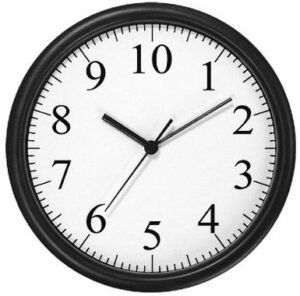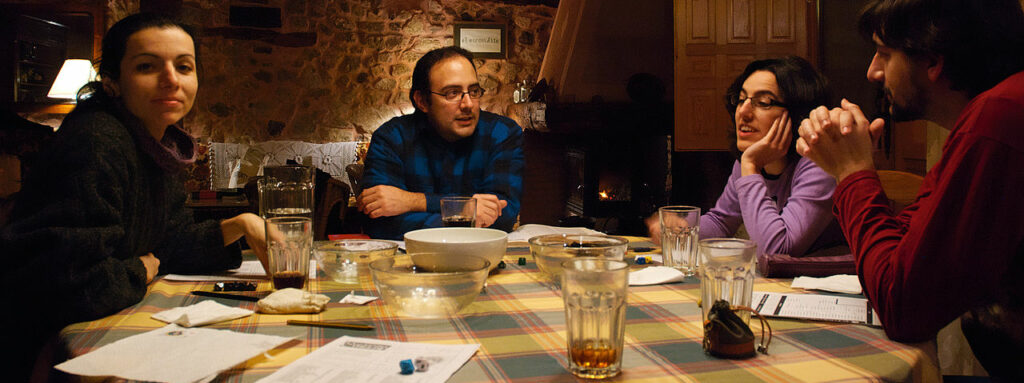Part 3 of a series on designing and running one-shot scenarios.
If you missed any of the earlier articles, find them here:
Designing the Adventure part 1 • Design part 2
Give out Characters Beforehand
If you decide to use pre-generated characters, send the character sheets to your players before game day. This will allow them to familiarize themselves with the character a bit. This is especially important for spell-casters, which are more complex to run than fighters. Distributing the sheets early also fosters excitement and anticipation for your game.
Bring Extra Stuff
Expect a few players to forget dice, pencils, and paper. These things take only a few minutes to gather, and the players in question will be grateful. Besides, you don’t want anything to delay you, as time is fleeting on game day.
Preroll For NPCs
 This is a trick that I’ve used successfully for years now. The slow pace of the combat round has been a bugbear in most versions of D&D, and I imagine that other games have similar problems. Though I learned from experience that AD&D (or 1st Edition) can move combat along quicker than later versions, pre-rolling attacks and damage will speed things up, no matter what version you play. Of course, you can do this in your regular campaigns too, but the practice is doubly helpful with single-session adventures.
This is a trick that I’ve used successfully for years now. The slow pace of the combat round has been a bugbear in most versions of D&D, and I imagine that other games have similar problems. Though I learned from experience that AD&D (or 1st Edition) can move combat along quicker than later versions, pre-rolling attacks and damage will speed things up, no matter what version you play. Of course, you can do this in your regular campaigns too, but the practice is doubly helpful with single-session adventures.
I usually roll between three and seven attacks for each monster, but use common sense. If you have twelve goblins, then perhaps thirty rolls are enough. Several goblins will likely die in the first few rounds, and if they are getting stomped, they will likely flee and end the combat. After rolling attacks, you can usually eyeball the numbers and figure out how many potential hits you have. If I rolled thirty times, I might see only ten rolls that are above a 14. Roll that many damage rolls and then add a few extra for good measure.
When you pre-roll damage or attacks, ensure that you include all known modifiers now. The more math that you do beforehand, the less you’ll need to do on game day, and combat will move that much quicker. Make sure that you are clear on what modifiers you already included (jot it down if necessary).
Make Cheat Sheets for Yourself
Consider making a cheat sheet for each expected encounter. I do this all the time. It includes my pre-rolled attacks and damage, as well as monster hit points, each PC’s Armor Class, what the monsters need to hit each PC, and what the PCs need to hit the monsters. On game day, when time is ticking, when excitement is high, and when momentum is building, you do not want to have to reference attack tables every few seconds. In more recent editions, those tables are gone anyway, but you still don’t want to ask players every few seconds, “What’s your Armor Class again?” With the most important numbers already on the cheat sheet, you can move things along at breakneck speed.
I also like to add notes for myself on what the monsters might do in the battle. While you can jot down the monster’s morale score, I usually just note that each monster will retreat if it falls to X hit points or less, or that they will all flee if half their number fall. It also helps to jot down any spells that a monster will likely cast in battle. Though I cannot know exactly when the monster will cast, I can note, for example, that he prefers to cast sanctuary first, then protection from normal missiles, and then sleep. Having that planned out beforehand will prevent excitement-killing delays on game day.
There are many other things that you might include on a cheat sheet, but the aforementioned items alone should make your combat encounters go quickly and smoothly. If you have plenty of free time, feel free to add any detail that you may need and do not have memorized. These could include modifiers for fighting in darkness, flanking bonuses, modifiers for battlefield terrain, drowning rules, the effects of a certain spell, etc.
Plan for Downtime
Given the time crunch on game day, remember that few games begin exactly on time (at least with my group!) You’ll also need bathroom breaks. Furthermore, if the session is long enough, you’ll want to eat a real meal in addition to the chips, cookies, and other snacks. If you ignore these truths and assume that players will use every second of the session to complete the adventure, you will certainly run out of time. Plan for downtime. Of course, your ability to do this will depend on the length of the session. If you are running a game session at a convention, then this tip may not apply, but it is especially helpful when running a ten-hour session with your friends.
First, ask your players to gather well before you wish to start the game. We usually meet an hour beforehand and eat breakfast together. My single-session adventures are usually an excuse to bring together friends that seldom get to play together. This means that they often want to chitchat about the last few years of their lives, and that eats time. Don’t fight it—plan on it. In fact, combining food and chatter kills two birds with one stone.
Next, plan on a short break every hour or two. It need only be five or ten minutes—just enough for bathroom breaks or to let people stretch their legs. Also, these brief breaks allow players to chitchat, to joke, to make a quick phone call, etc. I find that people have a need to do this, and if you don’t plan for it, these actions spill into the game, perhaps ruining the mood or causing delays.
Last, if the session is long, plan for a dinner break. Try not to go out for dinner (we made that mistake once). Order in.
Tune in next time for the exciting conclusion!
This is the third of four entries in this series. The full series includes:
Designing Single-Session Adventures part 1
Designing Single-Session Adventures part 2
Prep for Single-Session Adventures
Running the Single-Session Adventure

